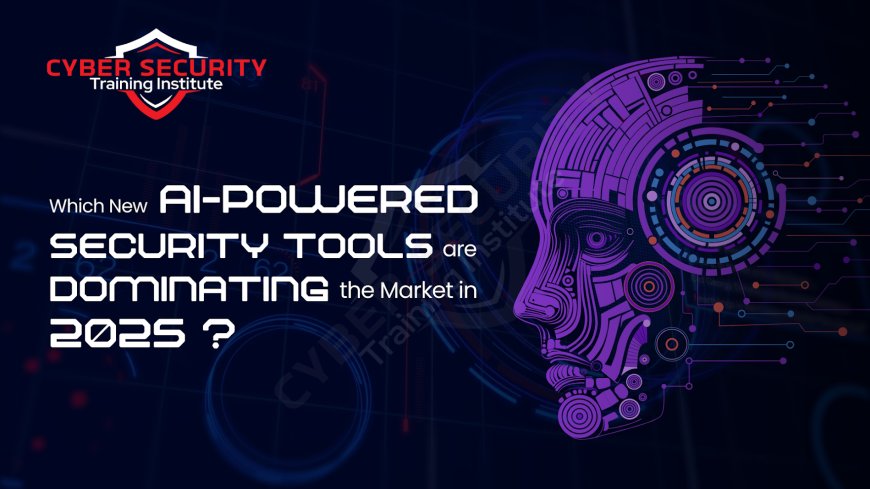Which New AI-Powered Security Tools Are Dominating the Market in 2025?
Explore the top AI-powered security tools dominating 2025's cybersecurity landscape, from SentinelOne QuantumAI to Microsoft Security Copilot. Which AI-powered security tools are leading the fight against modern cyber threats in 2025? Discover the top platforms, trends, and sectors adopting AI cybersecurity.

Table of Contents
- Introduction
- Why AI in Cybersecurity Is More Important Than Ever
- Top AI-Powered Security Tools in 2025
- How These Tools Work
- Industries Benefiting the Most
- Challenges in AI-Based Security
- Conclusion
- FAQ
Introduction
As cyber threats evolve, AI-powered security tools are stepping into the spotlight in 2025. With cybercriminals using AI to launch more sophisticated attacks, organizations now rely on artificial intelligence not just for detection, but for proactive defense and autonomous response. This blog explores which tools are dominating the market and why they matter.
Why AI in Cybersecurity Is More Important Than Ever
Traditional security solutions struggle to keep up with the speed, scale, and sophistication of modern attacks. AI brings the capability to process large datasets in real time, recognize threats instantly, and adapt to new attack vectors without human intervention. In 2025, AI is no longer optional — it's essential.
Top AI-Powered Security Tools in 2025
| Tool Name | Function | Key Feature | Used By |
|---|---|---|---|
| DarkTrace Nova | Threat Detection | Self-learning AI engine | Finance, Healthcare |
| Microsoft Security Copilot | Threat Analysis & Response | AI assistant for SecOps | Enterprises |
| SentinelOne Quantum AI | EDR & XDR | Predictive AI with deep learning | Tech, SaaS |
| CrowdStrike Charlotte AI | Endpoint Protection | Natural language threat queries | Government, Enterprises |
| Cybereason NeuralMap | Behavioral Detection | AI-based attack path tracing | Retail, Finance |
How These Tools Work
These tools use machine learning, natural language processing (NLP), and neural networks to analyze vast data streams and detect anomalous behavior in real time. Unlike static rule-based systems, AI-based tools evolve constantly, making them resilient to zero-day exploits and AI-driven malware.
Industries Benefiting the Most
Industries with sensitive data and high threat exposure have embraced AI cybersecurity tools the fastest:
- Finance: Fraud detection and transaction analysis.
- Healthcare: Ransomware prevention and patient data protection.
- Government: Protection against cyber espionage and advanced persistent threats.
- Technology: DevSecOps integration and cloud security enforcement.
Challenges in AI-Based Security
Despite their promise, AI tools face challenges:
- False positives: Overly sensitive AI can flag legitimate activity as malicious.
- Bias in models: Poor training data can lead to skewed detection.
- Adversarial AI: Attackers use AI to fool or reverse-engineer defensive models.
Organizations must strike a balance between automation and human oversight.
Conclusion
AI-powered security tools in 2025 are not just another product wave — they represent a paradigm shift in cybersecurity. By combining speed, adaptability, and intelligence, they offer unmatched defense in a world of relentless cyber threats. As AI continues to evolve, so too must the strategies and tools that secure our digital world.
FAQ
What is an AI-powered security tool?
It’s a cybersecurity solution that uses artificial intelligence to detect, prevent, and respond to threats automatically.
Why is AI becoming essential in cybersecurity?
AI can process and analyze data faster than humans, identifying patterns and threats in real time to prevent breaches.
What is the most popular AI security tool in 2025?
DarkTrace Nova and Microsoft Security Copilot are leading the market due to their advanced autonomous detection features.
Can AI tools replace cybersecurity professionals?
No, AI supports professionals by handling repetitive tasks, but human expertise is still needed for strategic decisions and investigation.
Are AI cybersecurity tools expensive?
Costs vary, but many tools now offer scalable pricing for SMBs, making AI protection more accessible than before.
How does AI detect unknown threats?
AI uses anomaly detection, machine learning, and behavioral analysis to identify threats that don’t match known signatures.
Can AI help with phishing attacks?
Yes, modern tools use NLP and email behavior analytics to detect and block phishing attempts in real time.
Is AI used for threat hunting?
Absolutely. AI can proactively scan networks, endpoints, and logs for indicators of compromise and alert analysts.
What is predictive threat detection?
It’s the ability of AI to forecast potential attack vectors based on historical data and current behavior patterns.
Which sectors benefit most from AI cybersecurity tools?
Finance, healthcare, government, and tech sectors are the largest adopters due to their critical data and high risk.
Are AI models vulnerable to cyberattacks?
Yes, they can be targeted using adversarial inputs or poisoned datasets, requiring regular tuning and validation.
What’s the difference between AI and ML in cybersecurity?
AI is the broader concept of machines mimicking human intelligence, while ML is a subset that learns from data to improve performance.
Can AI detect insider threats?
Yes, behavior-based AI tools can flag suspicious actions by users with internal access.
Is AI cybersecurity compliant with regulations?
Leading tools align with frameworks like GDPR, HIPAA, and NIST, but compliance depends on implementation.
What is autonomous response?
It’s when AI tools automatically isolate or neutralize threats without needing human intervention.
Can AI handle zero-day threats?
Yes, AI can identify anomalies and suspicious behavior to detect zero-day exploits before they cause harm.
Do AI tools support cloud security?
Yes, many AI tools are cloud-native and monitor activity across multi-cloud environments.
Are there open-source AI security tools?
Yes, tools like OpenAI SecBot and ELK Stack with ML plugins offer community-driven AI capabilities.
How often are AI models updated?
Top vendors update models continuously based on real-world threat feeds and telemetry data.
What’s the future of AI in cybersecurity?
Expect more collaborative AI-human workflows, automated threat intelligence sharing, and embedded AI in all layers of security.
What's Your Reaction?
 Like
0
Like
0
 Dislike
0
Dislike
0
 Love
0
Love
0
 Funny
0
Funny
0
 Angry
0
Angry
0
 Sad
0
Sad
0
 Wow
0
Wow
0














